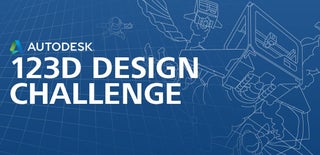Introduction: 123D SmartPhone Microscope
Have you ever been wanting to take a picture of something your looking at under your microscope but you just can't seem to get the lens matched up to the lens due to your shaky hands?
Well, with the phone microscope you can take all the pictures you want of magnified objects. In this instructable you can create a 3-D printable phone microscope (model) using 123D Design. I came up with this idea after looking at plants under my microscope and wanting to show my cousins who lives far away from me. I realized I had no way to take a picture of the magnified image I was seeing. This model would give me a solution to my problem.
Approx cost: Cost of printing?
Approx time: 2 to 3 hours
Difficulty level: Easy/Medium
If you like this instructable, please vote for me in the Autodesk 123D Design contest. :)
Step 1: Downloading the 123D Design App
In order to make this project, you have to download the 123D Design app. You can get this here: http://www.123dapp.com/design. Once on the website, click to download the 123D app for your computer. You could also choose to launch the web app. Next, choose you system and press download.
Step 2: Making the Base
First, start off with a square of length 150 millimeters, width 100 and height 10. Next, make two squares of length 50, width 50 and height 100. Place these squares on the ends of the other square. Make sure they are standing straight up like in the picture. Combine the three squares together.
Now, fillet the vertical edges of the bottom square by a radius of 5. Then, make a square of length 240, width 50 and height 20. Place this rectangle on top of the two columns like shown in the 4th picture. Fillet the edges of tall the vertical sides on the top rectangle by a radius of 5. Combine the top rectangle with the rest of the structure.
Step 3: Making the Rest of the Microscope
Make a square of length 70, with 80 and height 20. Carefully observe the second and third pictures for this part since it gets hard to explain using text for where to place the new rectangle. Once you have the rectangle in the right place, combine the new rectangle with the everything else. Then, fillet the vertical edges on the back of the new rectangle by a radius of 5. After completing that, make a cylinder of radius 4 and height 20. Stick this cylinder in the top rectangle that connects the two columns.
Step 4: Making the Lens and Future Ideas
Use the first picture to help you place the cylinder in the rectangle. You want to have the cylinder completely in the rectangle so that you can't see either side of the cylinder sticking out. This cylinder and the next cylinder would act as lenses. Since you can really 3D print a lens, this just serves as a placeholder for where the real lens would go. If the model was 3D printed, the lens placeholder would be removed. Also, since this is just a design I haven't put to much thought into what the lenses would be, although there are a lot of hand-held microscopes out there that could be rigged to fit in the lens spot.
Next, make another cylinder with radius 15 and height 30. Snap the top face of the bigger cylinder onto the bottom face of the smaller cylinder. You should just barely be able to make out the circle outline on the smaller cylinder. Congratulations! You are now done building my model. I added a black color and made the smaller cylinder black.
Improvements to this model I would include in the future would be:
- A LED attached to the inside of one of the columns to illuminate the specimen that you are viewing
- A knob to adjust the height of the columns, making it easier to focus

Participated in the
Build My Lab Contest

Participated in the
Autodesk 123D Design Challenge













